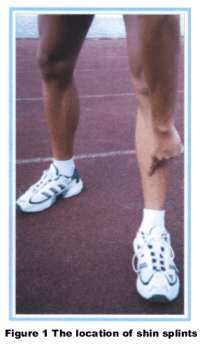Sports Medicine Education No. VII - Shin Splints
Introduction
"Shin splints" is not a specific diagnosis. It is a term used to describe pain and tenderness along the posteromedial border of the lower 1/3 of the tibia (Fig.1). It includes conditions like:
- media tibial stress syndrome;
- stress fractures and
- chronic compartment syndromes.

These conditions are common in activities that include running long distances, repetitive jumping or impact on hard surfaces. Sprinters, long distance runners, basketball and volleyball players, aerobic and classical dancers comprise most of the athletes with these problems.
Description
- Medial Tibial Stress Syndromes
They are caused by inflammation of the periosteum, tendon sheath, muscle belly, or interosseous membrane secondary to strain, minimal tears, or mechanical irritation. The symptoms usually occur only during activity and settle promptly with rest.
- Stress Fractures
They evolve from microfractures, which may become macroscopic defects. There is usually one area of exquisite discomfort to palpation on the bone. The symptoms occur with intense activities but ultimately with all weight-bearing activities or rest.
- Chronic Compartment Syndromes
They exist when increased intramuscular pressure during exercise impedes the blood flow and function of the tissues within the compartments (anterior, lateral, deep posterior and superficial posterior) in the osteofascial spaces (Fig.2). Pain is induced only by activity. The symptoms disappear fairly promptly at the cessation of exercise, although the tenderness may persist. Depending on the severity of the syndrome, numbness or tingling may occur in the distribution of the nerve that traverses the particular compartment.

Predisposing Factors to Shin Splints
- Inappropriate Footwear
Wearing worn-out shoes, shoes with insufficient arch support and poor shock-absorbing qualities, fails to counteract the repetitive jarring of the heel strike and may increase bone stress. Shoes that do not bend well at the toe box may increase the forces on the posterior compartment.
- Foot Shapes and Biomechanics
Overly flexible or flat foot may put additional stress on tibialis posterior, which is partly responsible for supporting the medial arch. Rigid cavus foot is poor in absorbing shock and may put extra stress on tibia.
- Poor Running Mechanics
Increased adduction of the leg increases functional foot pronation (Fig.3), thus increasing the activity of tibialis posterior. Excessive pronation is the major cause of medial tibial stress syndrome. Running with the hip externally rotated, leaning too hard while training on a track with excessively tight corners also tend to increase foot functional pronation. Forefoot contact running style may be important in the development of shin splints as it causes increased jarring in the leg.
- Overweight and Poor Conditioning
Individuals who are overweight may be susceptible to shin splints, as forces through the legs are multiples of body weight in running. The lower the level of conditioning, the greater the degree of overload placed on the body for a set workload. When running, this overload is predominately borne by the lateral and posterior compartment leg muscles.
- Muscle Imbalance and Inadequate Warm-Up
Shin splints may be secondary to stress generated by the tightness of the flexor digitorium longus, calf muscles and/or weakness of the foot intrinsic muscles or both. Warming up muscles before use increases the flexibility and blood flow in the muscles. Failure to do so may precipitate minor tears and the onset of inflammation.
- Inappropriate Training Surfaces
Repetitive running on hard surfaces may produce strains on tendons and bending forces on the tibia and fibula. Running over uneven ground or too many hills may place excessive stress on the various compartments of the leg.
- Overtraining
Training too much too soon will no doubt get you into trouble.
Treatment
- Active Rest
An initial period of rest from aggravating activities is necessary with athletes with severe symptoms and chronic course. Running in the water or cycling can be substituted. For stress fractures, full return to activity should await sound radiologic union when complete cortex is involved with a visible fracture line.
- Medication
Non steroidal anti-inflammatory drugs (NSAIDs) prescribed by the doctor are frequently helpful.
- Physiotherapy
Ice and electrical modalities can be used to reduce pain and inflammation. Specific stretching of tight muscles and strengthening of weak muscles should be performed as instructed by your physiotherapist.
- Orthosis and Footwear
Correction of varus heel (over-pronation), support of the medial longitudinal arch, as well as the introduction of shock-absorbing materials such as Sorbothane, may decrease symptoms. Worn-out shoes should be replaced. Shoes with a better support of the heel and medial longitudinal arch are recommended.
If conservative therapy is ineffective over a 4- to 6-week period and the symptoms are sufficiently disabling, surgery may be contemplated.
For more information, please contact:
Sports Medicine Department
Telephone: (852) 2681 6134
All information in this pamphlet is for reference only
 ID: hksportsinstitute
ID: hksportsinstitute

